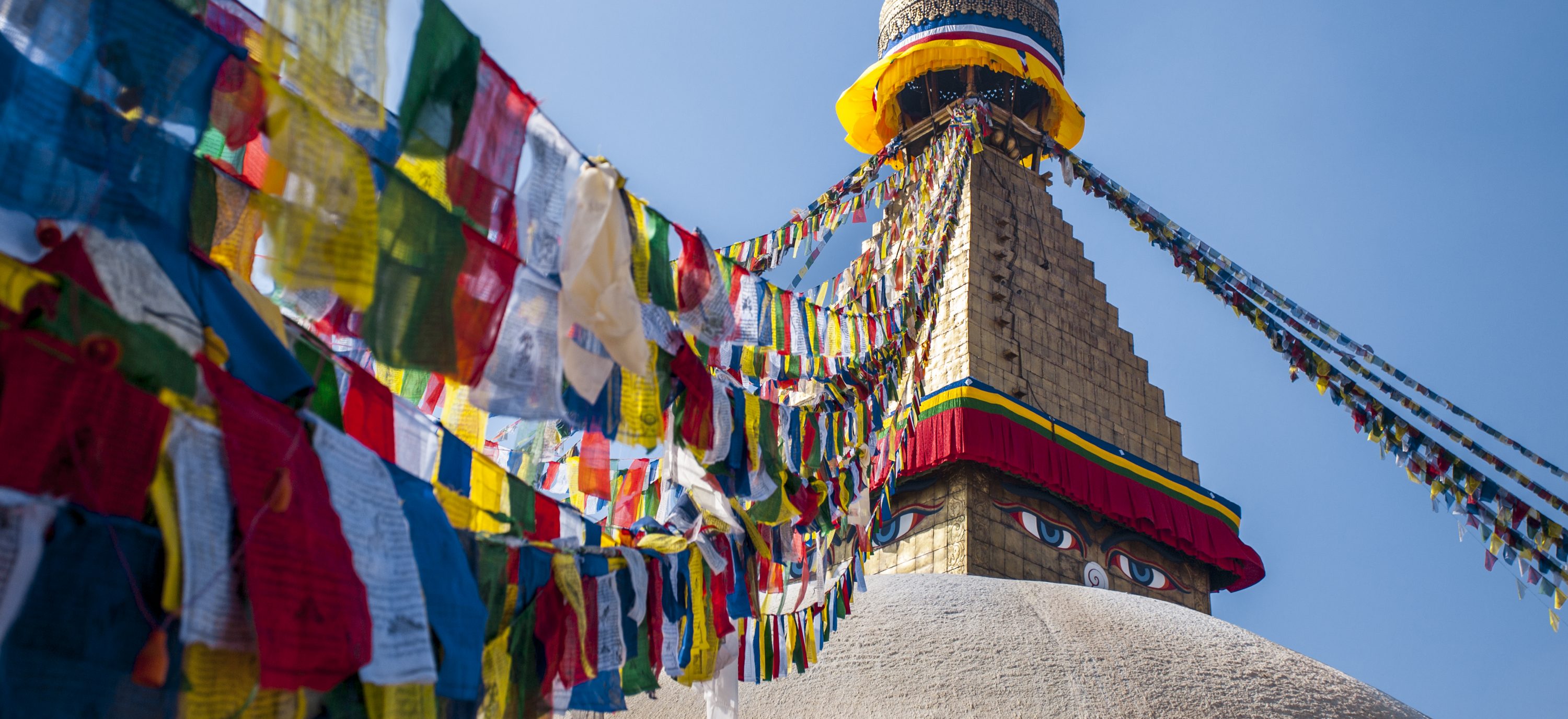The Himalayas are the highest-reaching and most dramatic collection of peaks in the world. Shaped like a crescent, the range curls unremittingly for 1,550 miles from Afghanistan to China and cradles Mount Everest, the tallest point above the Earth’s surface, which stretches 29,029 feet into the sky.
In comparison, Everest Base Camp sits at an elevation of 17,600 feet, abutting the southern face of Everest. For two months each spring and fall (the most stable weather windows), expedition teams that are pursuing Everest’s summit construct an anchorage of colorful tents atop the moraine at the mouth of Khumbu Glacier—a towering labyrinth of ever-shifting ice. The heap of granite and limestone rocks becomes a haven for 400-plus climbers to sort their gear, rest, acclimatize and seek shelter from bouts of weather.
Dwarfed by jagged ridgelines, Everest Base Camp is also a pinnacle for trekkers, where they can revel in the overwhelming vista and the culmination of their human-powered journey. So if you’re diving into planning your trek to Everest Base Camp, this guide will cover:
- Why Visit Everest Base Camp?
- Top Things to Do While Trekking to Everest Base Camp
- Top Things to Do in Kathmandu
- How to Get to Everest Base Camp
- Planning Your Trip
- How to Prepare for Everest
“Everest is in the DNA of the Co-op,” says Jeff Stivers, of REI. “The journey to Everest Base Camp has the power to transform one’s mind, body and spirit. Through the humility and care of our expert Sherpa guides, this fully supported trip will inspire you for the rest of your life.”
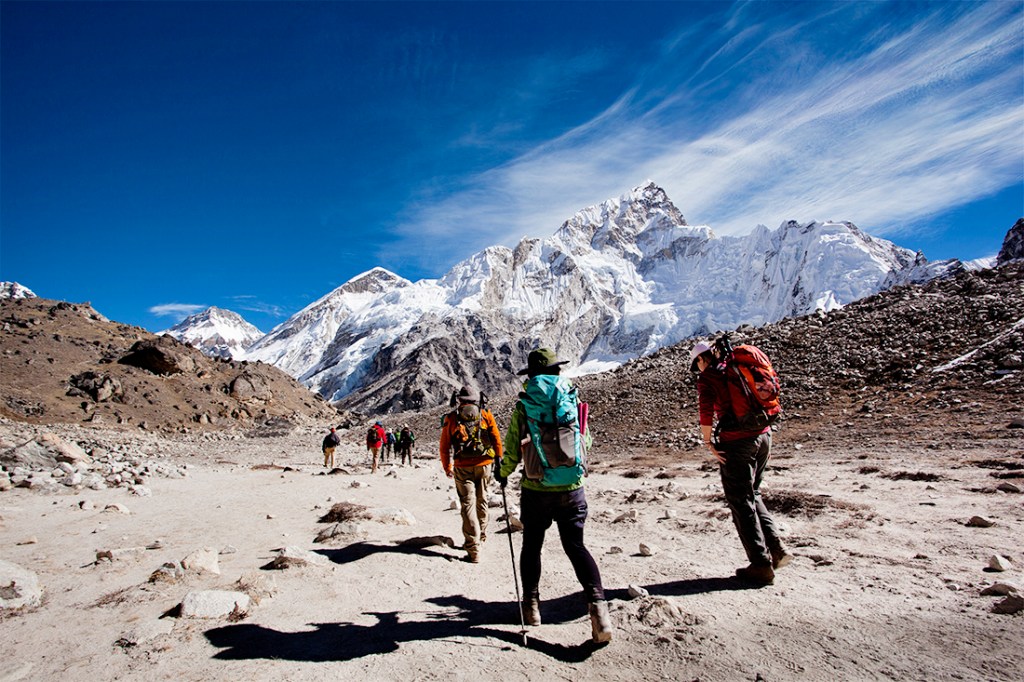
Nuptse and Lhotse rise up to meet a hiking group as they near Everest Base Camp.
Why Visit Everest Base Camp?
Remote and exposed, the Himalayas are home to the highest peaks on Earth. Throughout the starkly beautiful landscape, Sherpa villages are adorned with teahouses, prayer flags and wheels, chortens (pagoda-style structures), and painted mani stones.
You’ll find that the local Sherpa people—rooted in Tibetan Buddhism—have a spiritual reverence for the mountains and forest, preserve their traditional monasteries, and practice a peaceful coexistence with the land. But beyond the ancient customs, the unparalleled kindness of the Nepalese people is reason enough for thousands of trekkers to venture each year through this UNESCO World Heritage site toward Everest’s piercing silhouette.
The majority of the classic trek ascends through Sagarmatha National Park, which became a UNESCO World Heritage site in 1979. For 443 square miles, the reserve stretches northbound across Nepal’s Khumbu region until it reaches and surrounds Mount Everest. Sagarmatha’s protected landscape supports rare animal species such as the snow leopard and red panda, features six diverse vegetation zones, and holds glacial-fed rivers. To the northwest, Ngozumpa Glacier—the longest ice flow in Nepal—feeds the Gokyo lakes: six piercingly blue bodies of water that are the highest-elevation freshwater lakes in the world.
The journey to Everest Base Camp continues to grow in popularity with more than 75,000 trekkers exploring the Nepal Himalayas and 45,000 visitors entering Sagarmatha National Park in a given year. Rightfully so. The mix of exquisite topography, cross-cultural connection and available resources makes Everest Base Camp one of the most enriching treks on the planet.
Note: While all trekkers share the trails and teahouses in the Everest Base Camp area, most trekkers do not visit the climbing camp out of respect for the health and privacy of climbers.
Top Things to Do While Trekking to Everest Base Camp
Kala Patthar
This could be the best possible spot to watch a sunset shift light on the spire of Everest: from the soaring height of Kala Patthar, a ridge that sits due west of Everest and reaches an elevation of 18,510 feet. Hugging the base of the giant peak is Gorakshep, a small village that lies at 16,865 feet. After scoping out Khumbu Glacier, hikers can continue uphill to the settlement of Gorakshep, followed by the Kala Patthar climb.
In total, the round-trip excursion from Gorakshep to Kala Patthar (which means black rock in Nepali) is two miles with an elevation gain/loss of 1,645 feet—it’s steep. From the perch, travelers can see the brilliant cluster of tents at Everest Base Camp, as well as a panorama of Lhotse, Changtse and Nuptse peaks.
Pangboche Monastery
Constructed 350 years ago, Pangboche is the oldest monastery in the Everest region. Adorned in bright red paint, the Gompa (religious building) stands out among the terraces, which cradle the traditional light-toned homes and fields of its namesake village. The community gazes up at the immense, bright-white faces of the Himalayas.
After hikers leave the rhododendron forest and village of Phortse, they gradually make a 400-foot ascent to Pangboche. Overseen by a single monk, the ancient monastery is also the last permanent settlement located at the altitude of 12,795 feet along the trek to Mount Everest.
Himalayan Rescue Association
More than 40 years ago, the Himalayan Rescue Association of Nepal was established to help support the health and safety of climbers, trekkers and locals in the remote reaches of the Himalayas. The first-ever aid post launched in the village of Pheriche, at 14,600 feet in elevation. Pheriche’s clinic still thrives today and is recognized as the highest-elevation health facility in the world.

A group of hikers around Thokla Pass.
When you arrive in Pheriche, ask your teahouse host or the aid-post volunteers about the clinic’s daily presentations on altitude sickness and other travel-related illnesses. The talks are usually free to the public, interesting and informative and offer real-time data. Plus, you’ll get to meet other trekkers from around the globe.
Gokyo Lakes
The Gokyo Lakes are considered sacred to both Hindus and Buddhists. The centerpiece in a grouping of six lakes, Gokyo Lake is held in a magnificent crease between Gokyo Peak (also called, Gokyo Ri) and its life source: Ngozumpa Glacier, a 12.4-mile ice block and the longest glacier in Nepal.
A handful of hotels (around $14-$30 US per night) sit on the lateral moraine wall, which looks like a sharp spine that creates a border between Gokyo Lake and Ngozumpa. Alpine tundra with juniper shrubs and rhododendrons lead to the silty-clay water, which appears intensely teal against the quartz- and gneiss-speckled basin. Located at 15,583 feet in elevation, Gokyo Lake and its surrounding chain of pools are believed to be the highest collection of freshwater lakes in the world.
The first portion of the trek to reach Gokyo Lakes follows the same route for Everest Base Camp, so hikers can add a visit to Gokyo Lakes to their approach to Everest Base Camp, or their return. After reaching these Himalayan pearls, hikers can opt to ascend Gokyo Peak, which stands 17,575 feet above sea level and offers an earth-shattering glimpse of four of the six highest mountains in the world: Everest, Lhotse, Makalu and Cho Oyu.
Nangkar Tshang
In the village of Pheriche, trekkers can opt for a fulfilling push up to Nangkar Tshang Peak (also known as Nangkartshang Peak), a viewpoint that nears 16,700 feet above sea level. The hike is one of the most stunning experiences of the Everest Base Camp trek. Following a 2,100-foot climb, trekkers pass cliffside sacred sites to reach the sub-peak and are rewarded with a show of Lhotse, Makalu and Cho Oyu: three of the six highest peaks in the world. Between two nights in Pheriche, trekkers often weave this hike into their acclimatization day.
Top Things to Do in Kathmandu
Kathmandu is Nepal’s capital city in a hilly region on the edge of the Bhairav Kund Range. Founded in 723 AD, Kathmandu (which means, wooden temple) is a living museum brimming with Hindu and Buddhist religious sites, Newa architecture, stupas and traditional ceremonies. As the country’s largest metropolis and the primary gateway for travelers who are heading to the Himalayas, tourist-friendly accommodations and restaurants line the streets. The markets, narrow alleyways and roads of Kathmandu bustle with rickshaws, foot traffic and cars.
Tip: If you tend to catch travelers’ bugs, include a couple of extra travel days in Nepal post-trek.
Within the fast vibe, though, you’ll notice slow moments of warm hospitality extended from the Nepali locals, who practice a cultural value known as Atithi Devo Bhava, meaning, guests are equivalent to deities. There’s so much history and culture to explore in this city that it’s worth at least a couple of extra days. Prior to heading to the Himalayas, many trekkers plan on spending at least one day in Kathmandu to pick up any last-minute gear and permits.
Earthquake update: The April 2015 earthquake devastated Nepal, and the country suffered its worst loss of heritage since the earthquake of 1934. A total of 2,900 structures with cultural and religious significance were affected, including 691 historic buildings—of which, 131 were completely destroyed. In response, a union of archaeological experts and the Government of Nepal immediately launched a post-disaster plan to recover and reconstruct the damaged heritage sites within six years, by 2020.
To safeguard collections of artifacts, museums are using the aftermath as an opportunity to create digital inventories. New buildings will be retrofitted with seismic solutions. In some cases, extensive restoration work is necessary to re-create the original grandeur of immaculate sites. Yet, many palace buildings and temples also survived the tremor with only minor harm. Ultimately, Nepal’s recovery is well underway and many cultural sites have reopened.
For more information, read about REI’s mission to build an earthquake relief center in Namche Bazaar immediately after the disaster.
Swayambhu
Swayambhu is a UNESCO World Heritage site and the oldest Buddhist monument, a stupa, in Kathmandu Valley. Also known as Swayambhunath and Monkey Temple, the site is considered to be one of the country’s holiest Chaityas (prayer halls). The intimidating stupa is surrounded by a maze of shrines, statues, prayer wheels and monasteries that all stand together at the top of steep stairs built into a hillock that overlooks the entire city.
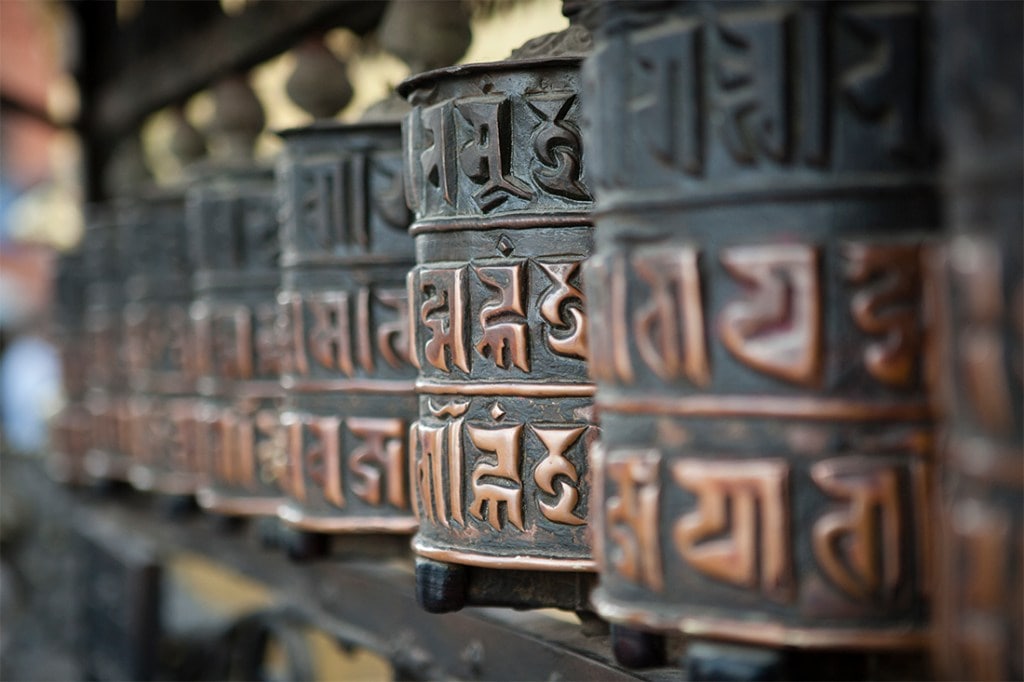
Prayer wheels are a common sight in Kathmandu and on the trek to Everest Base Camp. In Tibetan Buddhism, the wheels aid in expressions of devotion when spun clockwise by hand.
Legends say that Kathmandu valley was once filled with water, and the hill where Swayambhu stands was an island where a crystal stupa was placed. Eventually, a Buddhist monk drained the lake, so that anyone could visit the stupa and be liberated when the wind that blows around the structure touches them: Swayambhu literally means self-manifested. Today, the stupa is intended to represent Buddha’s teachings and to provide peace, freedom and joy.
Note: Entry fee required
Thamel
Thamel is the buzzing tourist epicenter of Kathmandu. Many travelers catch a ride from the airport to this frenetic hub of crisscrossed streets, where accommodations, restaurants and shops are all within a short walk of each other. The density of storefronts also includes tour agents, mountain guides and outdoor stores—where you can grab any layers or gear you may have left back home.
Durbar Square
Kathmandu’s Durbar Square is a UNESCO World Heritage site and is in the heart of the city. Durbar, meaning palace, is historically significant as a site of royal coronation. Today, the palaces, temples and public gathering spaces are still relished as a place to connect and reflect.
The majority of the square dates back to the 17th and 18th centuries—or even older—and came during a period of architectural evolution. Buddhism and Hinduism were flourishing throughout Asia, which strongly influenced the artistry and intricate ornamentation of the structures created during that era.
Note: Entry fee required
Pashupatinath
Pashupatinath was built in the 5th century and is considered to be one of the most important religious sites in Asia. The designated UNESCO World Heritage site features an enormous collection of significant antiquities including close to 492 temples, 15 shrines, and 12 phallic shrines. Situated northwest of Kathmandu, the complex sits along the banks of the Bagmati River. Pashupatinath is both a treasury for the past and a stage for the future where visitors can observe Hindus practicing their daily religious, spiritual and cultural rituals.
Note: Entry fee required
Tibetan Refugee Carpet Center
The Jawalakhel Handicraft Center was established by Tibetan refugees who fled from the Chinese invasion to seek asylum in 1959. Several organizations including the Committee of the Red Cross provided aid to help this community of skilled carpet weavers launch the center, which is also known as the Tibetan Refugee Camp. Beyond the hundreds of employees, the center is home to more than 1,000 Tibetans and is recognized as the pioneer of Nepal’s Tibetan carpet industry. Visitors can observe each stage of carpet production from wool sorting and hand-brushing to dyeing, trimming and yarn spinning.
How to Get to Everest Base Camp
Beyond the classic Everest Base Camp trek, there are a handful of trail variations that can add mileage to your standard route, extend your time on foot, and show you even more historic sites, natural landmarks and vistas along the way. After you land in Nepal, you’ll also have at least a half-day to discover the outstanding monuments in Kathmandu Valley.
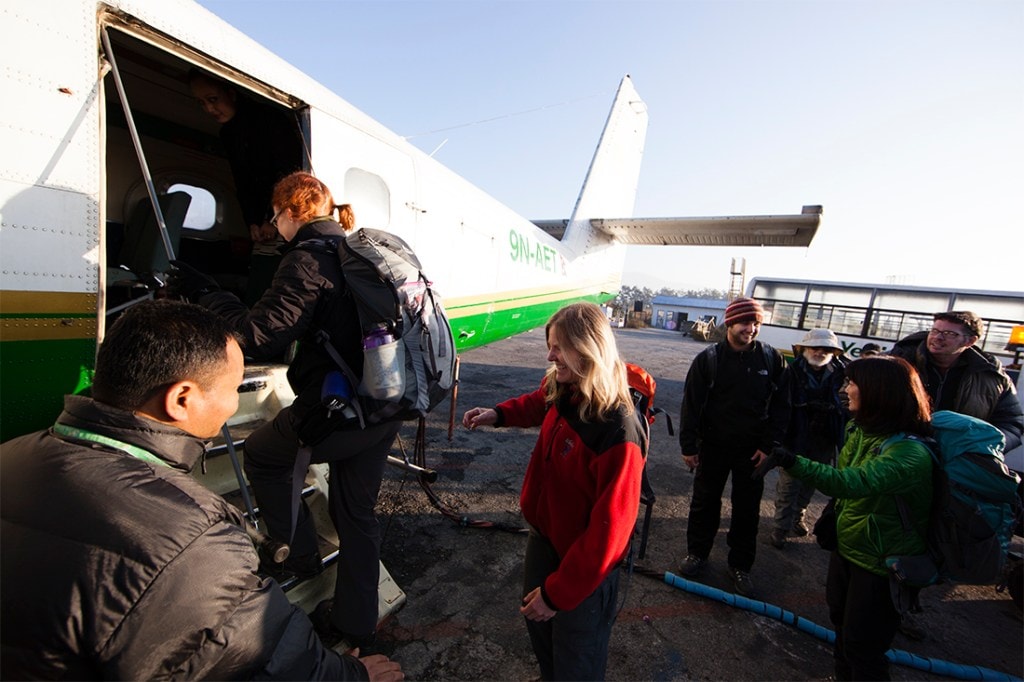
Air travel is a common means of access for hikers starting and ending the Everest Base Camp trek. Here, a tour group boards a flight at Tribhuvan International Airport in Kathmandu.
Fly into Kathmandu, Nepal
In eastern Nepal, Kathmandu is the country’s capital city and typically the first touchdown point for international travelers. If you’re not trekking with an organized group that will take care of your permits in advance, it’s helpful to plan on spending at least one day in Kathmandu after you land, so that you can rest and sort out logistics. If your schedule allows, the city is worth enjoying for a couple of days after you finish the Everest Base Camp trek.
Fly to Lukla, Nepal
Most people fly east from Kathmandu to Lukla, which is where the Everest Base Camp trek begins high on a mountain slope in the Khumbu region of the Himalayas. Some travelers land in the morning and start the trek the same day.
Travel to Jiri by Bus
Prior to the establishment of Lukla airport, trekkers used to start the Everest Base Camp trek in Jiri, Nepal. As the crow flies, Jiri is about 30 miles west of Lukla. Trekkers who want to experience this old-school iteration of the trek can take a scenic seven-hour-long bus ride through the countryside, from Kathmandu to Jiri, where the extended hike begins. When trekkers start in Jiri, they need about six to seven extra days to hike to Lukla. When they reach the village of Surkhe, they can also choose to veer north to Chaurikharka village and intercept the Everest Base Camp trek between Lukla and Phakding.
Trekking into Everest Base Camp
Pencil a few extra days into your travel plan so that you have the flexibility to be spontaneous and opt for side excursions if you choose. Having buffer days on your schedule can also help if you happen to experience any weather or flight delays, ailments or want to slow down the hiking pace. No matter how many days you spend trekking, you can’t go wrong.
Guides and porters are not required for the Everest Base Camp trek. But choosing a professionally predesigned trip can be a tremendous help for travelers who are new to Nepal, don’t have time to plan their own trek or simply love group travel. Some trekkers choose to hire porters—and no guide—so that they can travel each day with a lighter pack.
Most Everest Base Camp itineraries typically range from 17 to 20 days, which include a reasonable amount of time for rest and altitude adjustment in Kathmandu and in the high mountains. It’s also possible to complete the mileage in 14 days sans time for acclimatization. The effects felt by altitude are very personal and depend on each person.
Top Everest Base Camp Treks
The South Base Camp Trek in Nepal
The classic Everest Base Camp trek starts in Lukla and weaves through a handful of picturesque villages, which are painted in tones that stand out richly against the landscape—including Phakding, Namche Bazaar, Tengboche, Pheriche and Gorakshep—before reaching Everest Base Camp. The trek follows a network of trails and is adaptable, meaning hikers can visit other remote mountain villages and minor peaks along the way.
Overall, the classic trek is more or less an out-and-back with a gradual ascent into the Himalayas followed by a descent back to Lukla. The cumulative mileage and elevation varies greatly depending on which towns and summits you choose to link together. An average total distance ranges from 75 to 90 miles with 17,500 feet of vertical gain and loss.
The North Base Camp Trek in Tibet
On the north side of Mount Everest is a second base camp, tucked between the sweeping plateaus and mountains of the Tibet Autonomous Region of China, also known as the roof of the world. Much like the Himalayan communities of Nepal, this mountainous region is chock-full of spiritual monasteries, high-altitude monoliths and kind reception.
Before trekkers can enter this area they need to apply for a Chinese visa. Then, they need to apply for a Tibet Entry Permit, which is issued by the Tibet Tourism Bureau and is only obtainable through qualified travel agencies. Once trekkers fly from Kathmandu to Lhasa, they apply for the Aliens’ Travel Permit.
Note: Obtaining a Chinese visa can be a time-consuming process, so it might be a good idea to allocate extra time (3-4 days) for this leg of the journey.
Group Travel
Given that Nepal is a nerve center for experiencing the Himalayas, people from all around the world find what they need in Kathmandu and the surrounding villages for a successful, safe trip. The benefit of choosing a well-trodden path, rather than a lesser-known or undiscovered place, is that the adventure travel industry is up-and-running, which helps to support visitors and locals along the way.
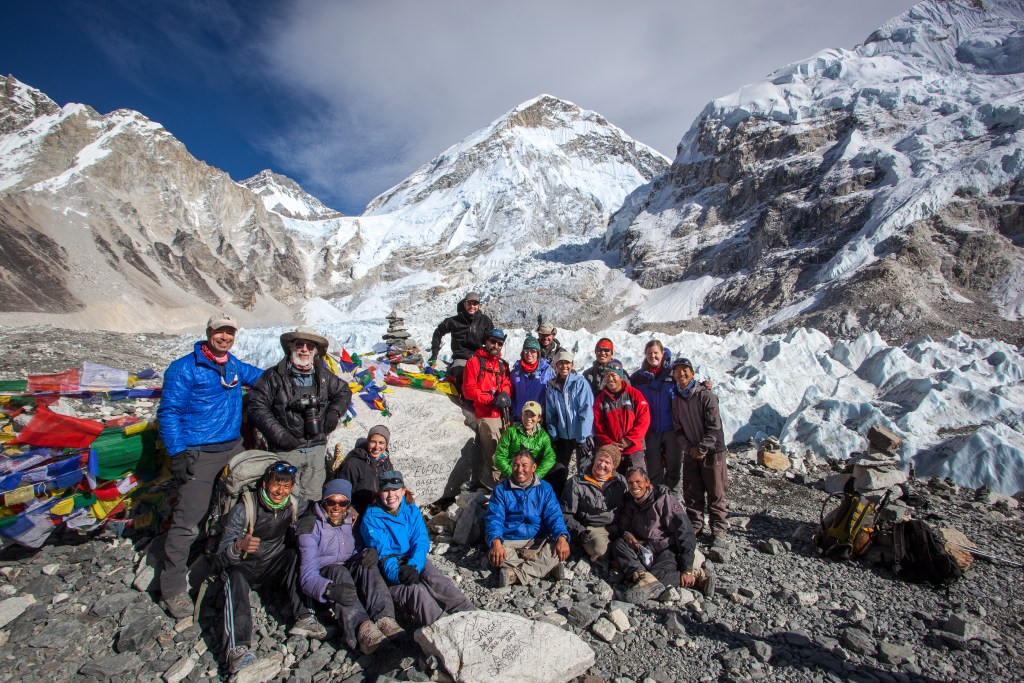
It’s possible to hike to Everest Base Camp without a group, but having a support team can make the trip relatively less challenging.
And since you’ll be hiking such a popular circuit, you’ll most likely see and meet other trekkers along the way who can become comrades on the trail or a potential soundboard if questions pop up. In each community, the teahouses are readily apparent and offer a place to dine and sleep overnight. Some even have hot water for a shower.
There are many benefits to joining a group trip. If you don’t have time to plan and organize your Himalayan trek, this is a streamlined, easy way to ensure that you minimize stress and maximize your enjoyment from preparation to finish.
Coordinated trips typically arrange the permits, guides, porters, accommodations and food on their trekkers’ behalf. Working with a single company provides a support system for questions you’ll have prior to landing in Nepal. Plus, walking and chatting with a guide each day can provide cultural insight and historic background, which helps to deepen the experience.
Planning Your Trip
Best Time to Visit Everest Base Camp
The best time of year to trek in the Himalayas of Nepal is March through May, and again in the fall, from September to November. In the spring (March and April), the rhododendrons bloom along the trails. After the spring season, the monsoon season picks up, and you can expect daily rain from June through September.
As a whole, October is the month with the largest number of trekkers in Nepal, followed by April and March. The highest visitation of international travelers to Sagarmatha National Park is also in October and November, followed by April, May and March.
The foremost climb period for summiting Mount Everest is April and May. So, if you’re excited to have the chance to meet mountaineers and observe the vibrant tent capital at the base of Everest, spring is the prime opportunity.
By October, there is less chance of mud on the trails following the summer monsoons. Plus, the air is particularly transparent with fewer clouds and heat haze, which means the outline of the surrounding peaks are even sharper. However, there’s always a chance of weather in the mountains and at high altitude: Snow can potentially dust the ground at any time of year, so be prepared for cold temperatures, no matter the season.
Everest Base Camp Permits
If you choose to travel solo and decline to have a tour operator manage your entrance tickets and permits, make sure to reserve your own. Current regulations (which are subject to change) is that Sagarmatha National Park requires an entry fee (3,000 Nepalese rupees, which is about $26 US), that can be paid at the Tourist Service Center located at Bhrikutimandap, Kathmandu.
Note: Bring extra rupees for any additional tax that could be included.
Trekkers also need to attain a Trekkers’ Information Management Systems (TIMS) Card (1,000 Nepalese Rupees per person in a group; 2,000 Nepalese Rupees for solo hikers; at print, 1,000 Nepalese Rupees is equal to $8.87 US), which can be picked up at the same Tourist Service Center. The TIMS counter office hours are from 10am to 5pm, seven days a week. The counter remains open on Saturdays and public holidays, too.
Travelers often plan to spend at least one day in Kathmandu prior to the day they fly to Lukla, so there’s time to square away these two permits before starting the trek. If you want to explore extra trails or peaks during your Everest Base Camp trek, be sure to confirm with the Tourist Service Center if you need to purchase additional permits for public land-use access, such as the Gaurishankar Conservation Area Permit or the Solukhumbu trekking permit.
How to Prepare
Getting in Shape
Treks in the Himalayas and to Everest Base Camp inherently follow rugged, sun-kissed trails that zigzag to very high altitudes: The majority of Sagarmatha National Park is barren and reaches higher than 16,000 feet above sea level. The colossal scale of the mountains and the region’s remoteness requires travelers to hike back-to-back days on foot while carrying a loaded backpack. Even athletic and fit travelers will benefit from preparing their body for walking in the mountains.
Packing the right gear is extremely important. Choose a sturdy set of hiking shoes or boots that are broken in, supportive enough for multiday use and that protect your feet from the rocky terrain. Practice walking on unstable trails that simulate the conditions of the trek. Start with a one-hour hike and gradually build stamina by increasing your time on foot until you can comfortably complete a six-hour day. In a given week, take a rest day after a few days of endurance work. As you train for your Himalayan trek, it might be natural to focus on the climb up—but don’t forget to prepare your body for the returning descent. Everest Base Camp is located at a much higher elevation than the start of the trek. Furthermore, in following the standard route, a hiker accumulates close to 17,500 feet of vertical gain and loss.
Altitude Acclimation
Everest Base Camp is perched at a very high altitude of 17,598 feet, and is surrounded by Himalayan peaks that reach even more extreme altitudes. Travelers can add excursions to even higher elevations, such as Kala Patthar peak, which offers a stunning snapshot of Everest from an elevation of 18,510 feet. But all trekkers begin their journey much lower: The most common port of entry in Nepal for travelers is Kathmandu, which sits at 4,593 feet above sea level. Lukla—where the trek to Everest Base Camp starts—rests at 9,383 feet in elevation.
Given the altitude of Everest Base Camp, historically, some hikers have experienced acute mountain sickness (AMS). AMS “is caused by reduced air pressure and lower oxygen levels at high altitudes,” according to the U.S. National Library of Medicine. Ascending quickly or not allowing for time to acclimatize can increase the risk for AMS.
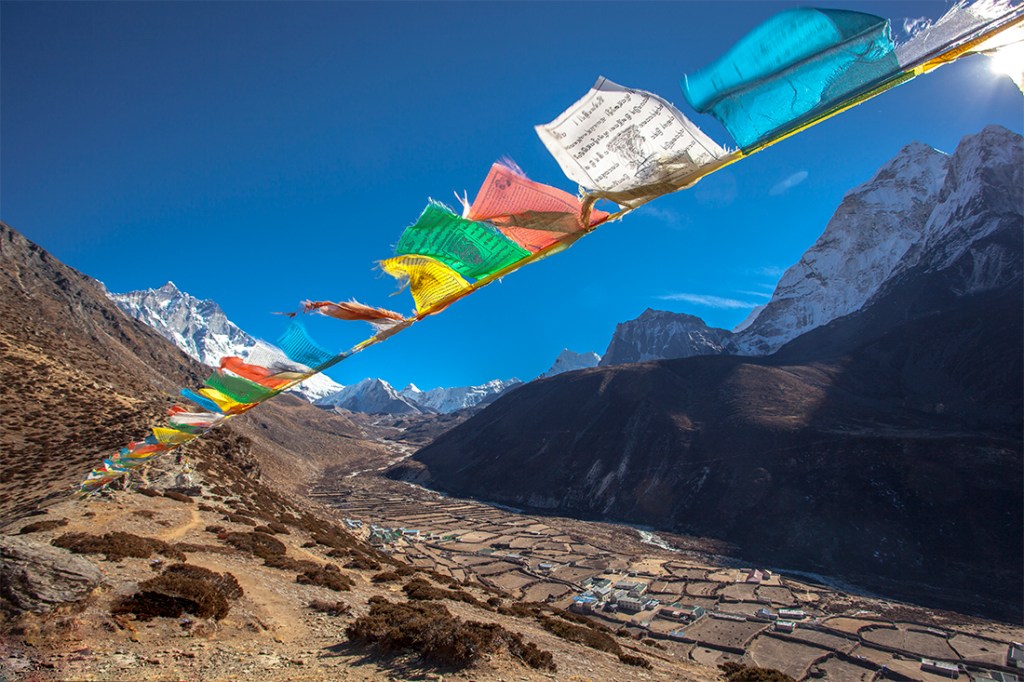
The Sherpa village of Dingboche is a popular place for trekkers to rest and acclimate.
In order to help prevent symptoms related to altitude, Princeton University’s Outdoor Action Guide to High Altitude recommends that hikers venturing above 10,000 feet should thereafter limit their increase in elevation to 1,000 feet per day. Hikers can also add one rest day for every three days of ascent. And if hikers do climb more than 1,000 feet in a day, they can always backtrack and sleep at a lower elevation if symptoms arise.
Guided trips often include days for rest and acclimation in Kathmandu and Lukla, as well as during the trek in high and very high altitude locations such as Namche Bazaar (11,286 feet), Dingboche (14,468 feet) or Pheriche (14,600 feet). For hikers who choose a longer expedition via Gokyo Lakes or Cho La Pass, another village where they can stop and acclimate is Machhermo (14,665 feet).
But no matter which itinerary you choose, Princeton’s OA Guide to High Altitude suggests staying hydrated, limiting alcohol consumption and avoiding sleeping pills. If you begin to feel symptoms—like a mix of a severe headache, nausea and weakness—consider staying put or descending to a lower altitude so that your body has a greater opportunity to adapt. (Disclaimer: REI Co-op Journal does not replace the guidance of a medical professional. Please seek direct advice from your personal health care provider regarding the altitude preparation, training, protocol and medication that is best for you.)
